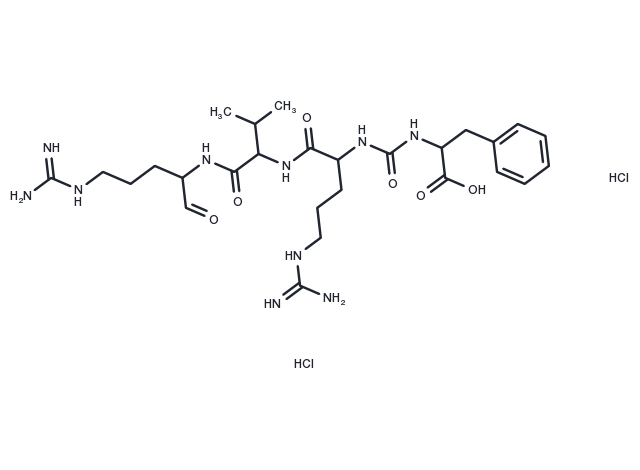store at low temperature
Powder: -20°C for 3 years | In solvent: -80°C for 1 year

Antipain dihydrochloride (Antipain 2HCl) is a protease inhibitor derived from Actinomycetes that exhibits analgesic activity and inhibits X-ray-induced chromosomal aberrations in human lymphocytes.

| Pack Size | Availability | Price/USD | Quantity |
|---|---|---|---|
| 2 mg | In stock | $ 142.00 |

| Description | Antipain dihydrochloride (Antipain 2HCl) is a protease inhibitor derived from Actinomycetes that exhibits analgesic activity and inhibits X-ray-induced chromosomal aberrations in human lymphocytes. |
| In vivo | Intact, cycling female mice received subcutaneous injections of Antipain dihydrochloride (3 mg) for 16 days, resulting in significant diminution in uterine weight and total DNA compared to untreated controls[1].Antipain dihydrochloride (100 μg/g body weight; i.p.; at 12-hour intervals from 0 to 120 h or 240 to 360 h) exhibits an inhibitory effect on urethane-induced lung neoplasia in mice[2]. |
| Synonyms | Antipain 2HCl, BDBM-32804, BDBM 32804, Antipain, BDBM32804 |
| Molecular Weight | 677.62 |
| Formula | C27H46Cl2N10O6 |
| CAS No. | 37682-72-7 |
store at low temperature
Powder: -20°C for 3 years | In solvent: -80°C for 1 year
You can also refer to dose conversion for different animals. More
bottom
Please see Inhibitor Handling Instructions for more frequently ask questions. Topics include: how to prepare stock solutions, how to store products, and cautions on cell-based assays & animal experiments, etc.
Antipain dihydrochloride 37682-72-7 Proteases/Proteasome Protease Antipain 2HCl BDBM-32804 BDBM 32804 Antipain Antipain HCl BDBM 32804, Antipain BDBM32804 Antipain Dihydrochloride inhibitor inhibit
